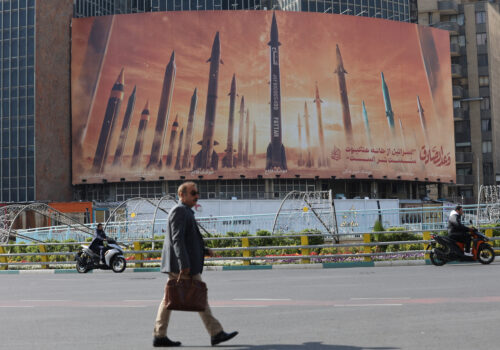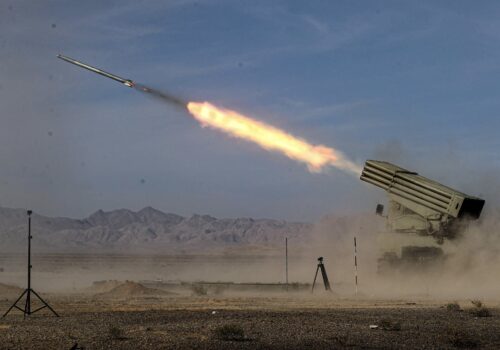Experts react: Israel just conducted a limited strike in Iran. Is this the end of the tit for tat?
It was a show of force. Early on Friday, the Israeli military reportedly carried out a strike on a military target near the Iranian city of Isfahan. While there is an Iranian nuclear facility nearby, early reports indicated that it was not hit in the strike, and Israeli and Iranian officials seemed eager to downplay the impact. How should we interpret the signals that both sides are sending? Is this the last move in a dangerous geopolitical chess match? Our experts are on the case.
This post will be updated as the news evolves and more reactions come in.
Click to jump to an expert analysis:
Jonathan Panikoff: Decoding the messages from the strikes
Shalom Lipner: Iran and Israel may now be ready to step back from the precipice
Beth Sanner: We have not yet reached the peak threat of escalation
Thomas S. Warrick: Both Iran and Israel are signaling the damage they could do next time
Rob Macaire: Expect more well-practiced ambiguity from both sides
Masoud Mostajabi: Further escalation is unlikely, but the conflict now moves back to the shadows
Decoding the messages from the strikes
In the early hours of Friday, Israel launched a retaliatory strike against Iran, targeting at least one military installation outside of Isfahan, some 275 miles south of Tehran, according to Israeli and US officials. The strikes were aimed at a military base or bases (it remains unclear) in Iran, just as one of Iran’s primary targets during its attack last weekend appeared to be Israel’s Nevatim air base. Israel appears to be sending three main messages with the strike.
Message one: This is a symmetrical, not proportional, response; but it is sufficient for Israel to close this particular chapter of direct military engagement with Iran. Unlike Iran’s significant escalation over the weekend—in which it used over three hundred ballistic and cruise missiles and drones—Israel’s strike made clear to Iran that it has the ability to successfully strike in and damage Iran, but can do so with far fewer weapons due to its superior technical capabilities.
Message two: Israel has the capability to target Iran’s nuclear program. What would have been escalatory is exactly what Israel did not strike. Not far from where the strikes occurred are a uranium conversion facility (UCF) and the Isfahan Nuclear Technology Center (INTC), they are part of one of Iran’s most prominent and important facility housing the country’s ongoing efforts to develop a nuclear weapon. The message from Israel is unusually clear: But make no mistake, Israel has the capability to successfully target the Isfahan UCF and NTC.
Message three: Israel will not permit Iran or its proxies to attack Israel with impunity. Israel will retaliate against an attack on its soil, no matter how little damage is done in that attack or how much Israel’s closest allies implore Jerusalem not to respond. Israel views doing so as a requirement for restoring deterrence, which has been increasingly fragile since the October 7 Hamas terrorist attack. Whether Israel’s response succeeded in restoring deterrence, for the time being, is now up to Iran.
Just yesterday, hours before the Israeli strike, Iranian Foreign Minister Hossein Amir-Abdollahian said that in the event of Israeli retaliation, “the next response from us [Iran] will be immediate and at a maximum level.” And Iran might ultimately choose to retaliate directly or through one of its proxies. But it is also wary of a major war with Israel and the immediate response by Iranian officials was to downplay the event, with one claiming that Israel’s attack was a “failed and humiliating” drone strike.
Tehran’s next move will indicate which of Israel’s messages got through to Iranian leaders.
—Jonathan Panikoff is the director of the Atlantic Council’s Scowcroft Middle East Security Initiative. He is a former deputy national intelligence officer for the Near East at the US National Intelligence Council.
Iran and Israel may now be ready to step back from the precipice
“Turning the other cheek” is a decidedly unpopular doctrine in the contemporary Middle East. While details of Israel’s retaliation against Iran will continue to emerge, what can be asserted confidently is that an Israeli response to the massive April 13 strike on its territory was a foregone conclusion. The ball is back in Iran’s court now. That said, indications are that Tehran and Jerusalem may both be ready to take a step away from the precipice of dangerous escalation.
The Netanyahu government could scant afford to let Iran’s launch of hundreds of unmanned aerial vehicles (UAVs), cruise missiles, and ballistic missiles on Israel go unanswered. Notwithstanding an extraordinarily high interception rate of incoming ordnance, the sheer magnitude of the Iranian assault—on the heels of Hamas’s rampage of October 7—posed a direct threat to the credibility of Israeli deterrence of its enemies. The contours of Israel’s raid reflected a balance between the imperative to project strength and the desire, simultaneously, to maintain the support of its allies in countering Iran’s aggressive behavior.
Multiple reports suggest that Israel took a surgical approach to the problem, limiting the scope of its action to a particular military airbase near Isfahan, and taking pains to exclude nuclear sites from its target list. Evidently, Israel, more than it sought to inflict damage on Iran, endeavored to send an explicit message that it possesses the potential to do so—should Israel determine it necessary. Keeping the Biden administration in the loop was the right move, given Israel’s increasing dependence on its foremost advocate.
Reaction in Iran—whose embassy to the United Nations tweeted amid its April 13 attack that “the matter can be deemed concluded”—has telegraphed that Tehran is looking now to end the current exchange. Iranian media has minimized the impact of the Israeli attack, offering that it involved only “small drones” and exacted no casualties. Commercial air traffic was restored quickly. Prevailing narratives in both Iran and Israel now allow for each side to claim satisfaction with their exploits and, more importantly, to scale down their posture.
The big question moving forward is whether this specific affair has inaugurated a new phase in the conflict, with Iran and Israel shifting gears toward direct engagement on each other’s home court. In this regard, an Iranian decision to take the lead—instead of working through terrorist proxies—will be influenced undoubtedly by the evolving challenge it faces from a US-engineered regional alignment, whose performance was instrumental in thwarting Iran’s designs to overwhelm Israel from the air.
What remains true is that the combination of volatility—headlined by Iran’s ongoing nuclear pursuits—and the ever-present danger of miscalculation, which appears to have afflicted Israel’s April 1 assassination of a top Iranian Revolutionary Guard Corps (IRGC) commander in Damascus, will keep the entire region on edge for the foreseeable future.
—Shalom Lipner is a nonresident senior fellow at the Scowcroft Middle East Security Initiative of the Atlantic Council’s Middle East Programs. He previously served seven consecutive Israeli premiers over a quarter-century at the Prime Minister’s Office in Jerusalem.
We have not yet reached the peak threat of escalation
Israel and Iran seem to have averted a regional escalation of the war, but the threat of escalation remains. Lying ahead are the same risks that existed before this round of escalation between Israel and Iran, centered on the threat from Hezbollah, but now in a context where the rules of the game have fundamentally changed.
The veil of the shadow war between Israel and Iran has been lifted and, with it, potential consequences for another round of escalation between one of its proxy forces and Israel or miscalculation in the ongoing shadow war that surely will continue. A Hezbollah missile and drone strike on an Israeli military base there on Wednesday wounded fourteen Israeli soldiers, six of them seriously, reminding us that this threat is far from resolved. More than sixty thousand Israelis remain displaced from the north, unable to return home because of ongoing fighting between the two sides and fears of residents that Hezbollah could execute an attack similar to Hamas’s October 7, 2023 attack.
Israeli leaders have warned that Israel can no longer live with this threat; Israelis overwhelmingly agree. Israeli military leadership has publicly warned they will use military force absent a diplomatic solution, and negotiations appear stalled. The ball seems very much to be in Israel’s court. Iran is seeking to play down the significance of the Israeli retaliatory strike, and Hezbollah’s second in command said earlier this week that it would not escalate unless Israel does. The next round of escalation may not be tomorrow, but is likely to come at a time and place of Israel’s choosing.
—Beth Sanner is a member of the Atlantic Council’s Iran Strategy Project advisory committee and a former US deputy director of national intelligence for mission integration.
Both Iran and Israel are signaling the damage they could do next time
On April 13, the world held its breath for about three hours while 330 drones and missiles headed towards Israel, with the prospect of a major war in the Middle East hanging in the balance. Israeli, American, and allied air forces brought down almost all of them, with only a few missiles landing near an Israeli base at Nevatim. Last night, the world held its breath for three hours before it became clear that Israel attacked an Iranian military facility near Isfahan—not Iran’s nearby nuclear facilities. When Iran claimed at dawn’s light that the explosions were from Iran’s air defenses, and that no explosives reached the ground, the feeling of relief across the Middle East and in Washington was almost palpable.
Both Israel and Iran have now made their point to each other this time that they have the ability the next time to do serious damage. Iran gave everyone advance warning about its April 13 attack, but said the next time it would act immediately and without warning.
By attacking a military facility outside Isfahan overnight, Israel demonstrated this time that the next time, it could mount a serious attack on Iran’s nuclear facilities and missile launching sites. About a dozen American and Israel experts and television commentators on X (née Twitter) and several cable news channels reached this conclusion between 10:43 p.m. and 10:53 p.m. Washington time.
Just as Iran’s April 13 attack was a demonstration of Iranian capabilities, the April 18-19 strike demonstrates Israel’s capabilities.
Let’s hope that the Iranian regime leadership has reached the same conclusion. If Iran wants to tell its people that nothing important happened the night of April 18-19, perhaps that will be the end—of this round.
—Thomas S. Warrick is a senior fellow and director of the Future of DHS Project at the Atlantic Council. He served in the Department of State from 1997-2007 and as deputy assistant secretary for counterterrorism policy at the US Department of Homeland Security from 2008 to 2019.
Expect more well-practiced ambiguity from both sides
Since Iran’s mass missile and drone attack against Israel on April 13, there has been intense diplomatic pressure on the Israeli leadership not to respond provocatively—to ‘“take the win” in US President Joe Biden’s words. The United Kingdom has been among those urging restraint and was also among those helping to thwart that Iranian attack. Realistically, a non-response from Israel was never likely. But if the attacks that are now being reported (allegedly on targets in Isfahan, with Iran playing them down) are the sum total of Israel’s response, further escalation may be avoided. That doesn’t mean that attacks by both sides won’t continue. But they may revert to where they have been over recent months, with a combination of calibrated actions.
Iran’s missile/drone attack was designed to show that Israel couldn’t with impunity carry out actions like the killing of IRGC generals in a Damascus consulate building. Israel’s overnight attacks are presumably intended to show that they can and will continue to strike inside Iran, even if in the past they have not often acknowledged doing so. If, as appears to be the case, the attacks turn out to be against Iran’s drone and missile manufacturing operations in Isfahan, the signal will be one of direct linkage to Iran’s attack, and a line may be drawn. If the attacks had been against nuclear research and development facilities, Iran could have been expected to react by ramping up its nuclear program (every major step up in the program has been in the wake of actions against it, whether sanctions or sabotage).
Iran’s underlying objective in this situation remains the same—to stoke instability. If Israel’s primary objective is to deter Iran, and build a coalition to more effectively control it, there’s an incentive to be restrained at this point. If, however, Israel sees an interest in precipitating conflict with Iran, and potentially drawing in the United States, it would logically continue with more provocative attacks. Both countries are well practiced at operating with ambiguity. So Israel may not want to indicate clearly whether the overnight attacks have completed its response to Iran’s strikes last week.
—Rob Macaire is a member of the Atlantic Council’s Iran Strategy Project and a former ambassador of the United Kingdom to the Islamic Republic of Iran.
Further escalation is unlikely, but the conflict now moves back to the shadows
Following the calibrated strike by the Islamic Republic of Iran over the weekend, Israel’s vow of revenge meant it simply was not willing to appear weak. However, Friday’s response was similarly measured. According to Iranian officials, the response employed only a few unmanned aerial vehicles (UAVs) that were easily intercepted by Iranian air defenses, just as the hundreds of Iranian drones and missiles were easily intercepted by Israeli and allied air defenses.
Israel has reportedly used similar UAVs previously without provoking a strong reaction from Iran. Therefore, the Israelis apparently deemed this approach a way to look strong while not escalating the conflict. Yet it also served as a subtle warning that Israel would not hesitate to target Iranian soil if tensions boil over.
Despite Iran’s claims that it would decisively respond to an Israeli attack, Iranian media downplayed the significance of the Israeli strikes, indicating a willingness to call it even at this stage and negate immediate retaliation. Thus, an immediate escalatory response from Iran seems unlikely.
The United States, alongside much of the international community, can step away from Friday’s strikes with a sigh of relief, having spent the past week urging Israeli leadership to show restraint and prevent further escalation.
For now, this chapter appears to have concluded, marking a return to the “shadow war” between the two regional adversaries. Nonetheless, for as long as the war on Gaza rages, the risk of miscalculation and a widening of the conflict that could draw in regional and international players remains at unprecedented levels.
—Masoud Mostajabi is a deputy director of the Middle East Programs at the Atlantic Council.
Further reading
Mon, Apr 15, 2024
Iran and the de-escalation myth
Inflection Points Today By Frederick Kempe
It won’t be de-escalation that will save lives after Iran’s unprecedented weekend attack, but a more determined and unmistakable deterrence.
Sun, Apr 14, 2024
Iran is trying to create a new normal with its attack. Here’s how Israel and the US should respond.
New Atlanticist By William F. Wechsler
Tehran is trying to set a precedent that it can attack Israel directly, that it can do so from Iranian soil, and that it can target civilians inside Israel.
Sat, Apr 13, 2024
Will Iran’s unprecedented strike on Israel lead to a regional war?
Fast Thinking By Atlantic Council
Iranian forces launched more than two hundred drones and missiles against Israel. Atlantic Council experts share their insights on what might happen next.
Image: Iranian President Ebrahim Raisi (2nd R) is addressing attendees at a military parade marking Iran’s Army Day anniversary at an Army military base in Tehran, Iran, on April 17, 2024. (Photo by Morteza Nikoubazl/NurPhoto)




